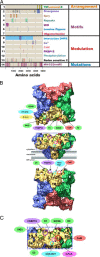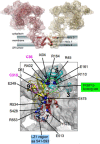Ryanodine receptor structure: progress and challenges
- PMID: 18927076
- PMCID: PMC3837402
- DOI: 10.1074/jbc.R800054200
Ryanodine receptor structure: progress and challenges
Figures


Similar articles
-
Structural determination of the phosphorylation domain of the ryanodine receptor.FEBS J. 2012 Oct;279(20):3952-64. doi: 10.1111/j.1742-4658.2012.08755.x. Epub 2012 Sep 11. FEBS J. 2012. PMID: 22913516 Free PMC article.
-
Structural and functional interactions within ryanodine receptor.Biochem Soc Trans. 2015 Jun;43(3):377-83. doi: 10.1042/BST20140292. Biochem Soc Trans. 2015. PMID: 26009179 Review.
-
Mutational analysis of putative calcium binding motifs within the skeletal ryanodine receptor isoform, RyR1.J Biol Chem. 2004 Dec 17;279(51):53028-35. doi: 10.1074/jbc.M411136200. Epub 2004 Oct 6. J Biol Chem. 2004. PMID: 15469935
-
Structural insights into endoplasmic reticulum stored calcium regulation by inositol 1,4,5-trisphosphate and ryanodine receptors.Biochim Biophys Acta. 2015 Sep;1853(9):1980-91. doi: 10.1016/j.bbamcr.2014.11.023. Epub 2014 Nov 25. Biochim Biophys Acta. 2015. PMID: 25461839 Review.
-
Identification of an amino-terminus determinant critical for ryanodine receptor/Ca2+ release channel function.Cardiovasc Res. 2021 Feb 22;117(3):780-791. doi: 10.1093/cvr/cvaa043. Cardiovasc Res. 2021. PMID: 32077934 Free PMC article.
Cited by
-
Ryanodine receptors: structure and function.J Biol Chem. 2012 Sep 14;287(38):31624-32. doi: 10.1074/jbc.R112.349068. Epub 2012 Jul 20. J Biol Chem. 2012. PMID: 22822064 Free PMC article. Review.
-
Ryanodine receptors: structure, expression, molecular details, and function in calcium release.Cold Spring Harb Perspect Biol. 2010 Nov;2(11):a003996. doi: 10.1101/cshperspect.a003996. Epub 2010 Oct 20. Cold Spring Harb Perspect Biol. 2010. PMID: 20961976 Free PMC article. Review.
-
Calcium-Handling Defects and Neurodegenerative Disease.Cold Spring Harb Perspect Biol. 2020 Jul 1;12(7):a035212. doi: 10.1101/cshperspect.a035212. Cold Spring Harb Perspect Biol. 2020. PMID: 31427373 Free PMC article. Review.
-
Ryanodine Receptor Structure and Function in Health and Disease.Subcell Biochem. 2018;87:329-352. doi: 10.1007/978-981-10-7757-9_11. Subcell Biochem. 2018. PMID: 29464565 Free PMC article. Review.
-
Structural determination of the phosphorylation domain of the ryanodine receptor.FEBS J. 2012 Oct;279(20):3952-64. doi: 10.1111/j.1742-4658.2012.08755.x. Epub 2012 Sep 11. FEBS J. 2012. PMID: 22913516 Free PMC article.
References
-
- Serysheva II, Chiu W, Ludtke SJ. Methods Cell Biol. 2007;79:407–435. - PubMed
Publication types
MeSH terms
Substances
Grants and funding
LinkOut - more resources
Full Text Sources
Other Literature Sources
Molecular Biology Databases

